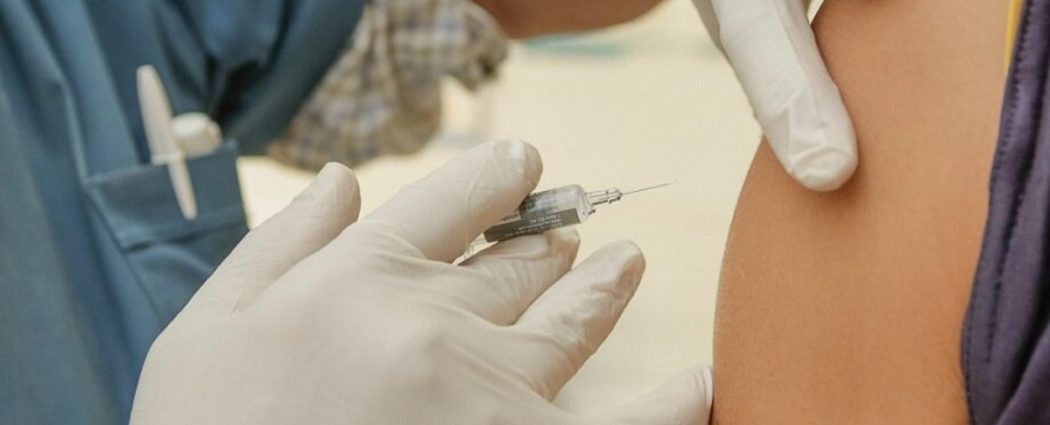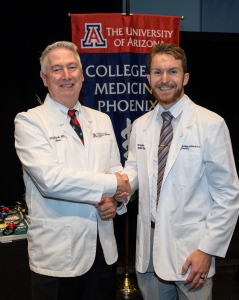Many are taking solace in the new year after a rough 2020. Healthcare workers (including medical students) find themselves patiently waiting in long lines of cars outside of massive white tents, watching each person in front them get approached by a masked stranger who says a few words, wipes off their shoulder with an alcohol pad, and quickly jabs them with a surprisingly small needle that contains the first dose of the COVID-19 vaccination. At the time of writing, almost 50,000 people in Maricopa County have received their first dose of the Pfizer or Moderna vaccines [1], marking the beginning of the end for the pandemic that has taken control of our lives, and caused many to lose theirs.
The effort to create the vaccine was historic, and the logistics of administering the vaccine are no less so. The United States is currently in “Phase 1a” of the vaccination schedule, focusing on healthcare workers and residents of long-term care facilities, populations that are arguably the most at risk of contracting the virus. While on paper it seems like a “common sense” move to vaccinate healthcare workers first, there are nuances and issues that are creating frustrations for many.
On December 22nd, Abrazo West was geared up to vaccinate hundreds of healthcare workers, with dozens of volunteers, pharmacists, nurses, paramedics, and physicians at-the-ready outside of large white tents for those with appointments to get vaccinated. Even the National Guard was on-site to assist with logistics.
The expected swarm of vehicles did not show up, however, and the Arizona Department of Health Services found that their scheduling software and email system to set up appointments were rife with glitches and errors. While volunteers and vaccinators stood mostly idle, vaccinating perhaps 1 or 2 people every hour, healthcare workers were frustrated to find that they were being told that no appointments were available, or that no locations for distribution were open.
In the beginning days of vaccine administration, these issues compounded into painstakingly low numbers of healthcare workers getting vaccinated and resulted in many of the frustrated people showing up without appointments. The staff at the vaccine point of distribution then had to decide: would they vaccinate anyone who showed up and could prove that they were a healthcare worker? Leadership on-site was quick to say “We aren’t turning anyone away”, deciding that the cumbersome registration software could be reconciled later, so long as people could get their vaccine.
What was strange and surprising were the healthcare workers that were able to get appointments. Physicians from pain clinics, medical students, EVS workers, unit secretaries, and outpatient clinic staff showed up in impressive numbers to receive their vaccinations in the first days. At the same time, residents working with COVID patients in the ICUs, emergency nurses on the front lines, and paramedics entering homes of COVID-uncertain patients were unable to secure appointments.
While there is no doubt that all the aforementioned healthcare workers need to get the vaccine, many have expressed frustration with the order in which it has happened. Healthcare workers who have not (and will not) see symptomatic COVID patients were being vaccinated quickly, while some emergency department workers were told that they would not be able to receive the vaccination until the second or third week of January (nearly a month after the vaccine points of distribution had opened).
The situation in Maricopa County has almost certainly not been one of misappropriation, but rather it is likely the result of faulty software and technical issues. As of today, many of these issues have been reconciled and frontline nurses, physicians, paramedics, and other healthcare workers have been able to receive their first vaccine doses.
However, this situation was not unique to Maricopa County. Anger from places like Stanford Health was heard across the nation, when seven frontline medical residents were selected to receive the vaccine… out of 5,000 doses [2]. The other doses went to many administrative and executive workers, who had primarily been telecommuting their jobs from home. Stanford had allegedly worked on the algorithm “for weeks” with ethicists and infectious disease experts, but when it came time to utilize the algorithm things inexplicably fell apart.
Stanford quickly rectified the situation, after hundreds of residents protested and the issue caught national attention. But the question remains: how is it that these algorithms are being rolled out with such glaring flaws? Both at Stanford and here in Maricopa County, issues with the software and an apparent over-reliance on technological algorithms have delayed essential workers on the frontline from receiving their vaccine. Is this simply a technical issue? Is it an issue of negligence, or an unavoidable complication? And when the system fails, should we just toss it aside and vaccinate any who ask, like what was done in Maricopa County?
In the coming weeks and months, vaccination distribution will be expanded to 1b, including police, firefighters, public sector employees, and others. This group of Americans encompasses nearly 90 million people [3], a significant increase from the evidently already-burdened logistically process of vaccination of several million healthcare workers. While the technical issues are being resolved day-by-day, there is a lot of work that needs to be done to avoid a logistical and ethical catastrophe when vaccination administration ramps up tenfold.
- COVID-19 Vaccine | Maricopa County, AZ. Maricopa.gov. https://www.maricopa.gov/5641/COVID-19-Vaccine. Published 2021. Accessed January 2, 2021.
- This is the Stanford vaccine algorithm that left out frontline doctors. MIT Technology Review. https://www.technologyreview.com/2020/12/21/1015303/stanford-vaccine-algorithm/. Published 2021. Accessed January 2, 2021.
- COVID-19 and Your Health. Centers for Disease Control and Prevention. https://www.cdc.gov/coronavirus/2019-ncov/vaccines/recommendations.html. Published 2021. Accessed January 2, 2021.
Chris Laube is a student in the class of 2023. He was an EMT prior to med school, where he met his wife, and attended most community colleges in the Phoenix area as well as ASU. When not on rotations, he enjoys spending time with his wife and kids, pretending to be an endurance athlete, and video games.


